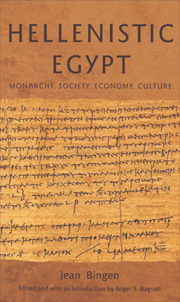Book contents
- Frontmatter
- Contents
- Original Sources of Chapters
- List of illustrations
- Glossary
- Maps
- Foreword
- Introduction: Jean Bingen and the currents of Ptolemaic history
- Part I The Monarchy
- Part II The Greeks
- 6 The Thracians in Ptolemaic Egypt
- 7 Ptolemaic papyri and the Achaean diaspora in Hellenistic Egypt
- 8 Greek presence and the Ptolemaic rural setting
- 9 The urban milieu in the Egyptian countryside during the Ptolemaic period
- 10 Kerkeosiris and its Greeks in the second century
- 11 The cavalry settlers of the Herakleopolite in the first century
- 12 Two royal ordinances of the first century and the Alexandrians
- Part III The Royal Economy
- Part IV Greeks and Egyptians
- Conclusion
- Bibliography
- General index
- Index of passages discussed
- HELLENISTIC CULTURE AND SOCIETY
11 - The cavalry settlers of the Herakleopolite in the first century
from Part II - The Greeks
- Frontmatter
- Contents
- Original Sources of Chapters
- List of illustrations
- Glossary
- Maps
- Foreword
- Introduction: Jean Bingen and the currents of Ptolemaic history
- Part I The Monarchy
- Part II The Greeks
- 6 The Thracians in Ptolemaic Egypt
- 7 Ptolemaic papyri and the Achaean diaspora in Hellenistic Egypt
- 8 Greek presence and the Ptolemaic rural setting
- 9 The urban milieu in the Egyptian countryside during the Ptolemaic period
- 10 Kerkeosiris and its Greeks in the second century
- 11 The cavalry settlers of the Herakleopolite in the first century
- 12 Two royal ordinances of the first century and the Alexandrians
- Part III The Royal Economy
- Part IV Greeks and Egyptians
- Conclusion
- Bibliography
- General index
- Index of passages discussed
- HELLENISTIC CULTURE AND SOCIETY
Summary
In Ptolemaic Egypt the first century bc constitutes a period relatively poor in papyri, although the documents from the Herakleopolite are gradually improving this situation. This scarcity has certainly impaired our vision of what the realm was by this time. Dynastic events and the increasing influence of Rome are so prominent that they tend to obscure the importance of a certain number of social developments that we would like to clarify. The relative shortage of written documents has given the impression that outside of Alexandria those seventy years constitute only a languishing and rather dull transition period between the disturbances of the second century and the implementation of the Augustan order in Egypt. In this hazy context, one imagines only too easily the continuation of some theoretical linear processes, such as a decline of the power of the throne, an increasing power of the Egyptian clergy, or other current working hypotheses suggested by a rather superficial reading of, among other documents, the edicts of Euergetes II or the asylum decrees from the first century (see Chapter 19).
If we except that epigraphical dossier, the last reigns of the Ptolemies are illustrated in the main, as I have said, by papyri from the Herakleopolite nome. Two groups of texts, one concerning the transfer of katoikic allotments and the other petitions to the strategos, published in BGU VIII and X respectively, have been particularly exploited.
- Type
- Chapter
- Information
- Hellenistic EgyptMonarchy, Society, Economy, Culture, pp. 132 - 140Publisher: Edinburgh University PressPrint publication year: 2007

